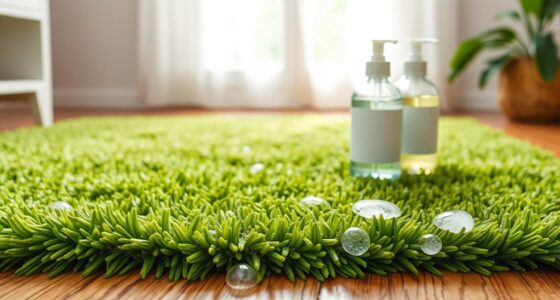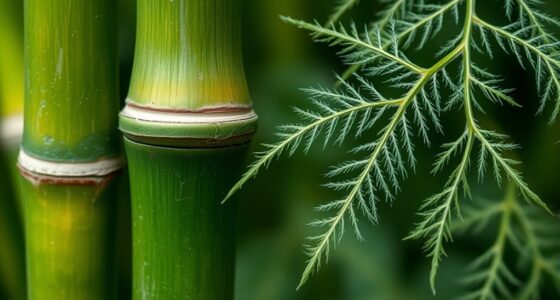Creating resilient landscaping with native and drought-tolerant plants helps you design a sustainable, low-maintenance estate that thrives in changing climates. These plants reduce water use, require less upkeep, and support local wildlife, all while maintaining a luxurious appearance. By choosing species adapted to your region’s conditions, you guarantee a vibrant landscape that endures droughts and extreme weather. Discover how the right plant selections can transform your estate into an eco-friendly, stunning retreat.
Key Takeaways
- Selecting native and drought-tolerant plants reduces water use and maintenance, ensuring sustainable, low-impact luxury estate landscapes.
- Incorporating deep-rooted species enhances resilience against drought and extreme weather conditions.
- Designing with plants that share similar light and water needs simplifies care and promotes ecological harmony.
- Using diverse textures and colors of native plants creates visually appealing, dynamic landscapes with minimal intervention.
- Focusing on eco-friendly features supports biodiversity, lowers environmental impact, and maintains a luxurious estate aesthetic.

Creating a sustainable and low-maintenance landscape begins with choosing native and drought-tolerant plants. When you focus on plant selection, you’re making a conscious decision to prioritize species that are naturally adapted to your region’s climate, soil, and water availability. This approach not only reduces your water and maintenance needs but also enhances the overall resilience of your estate’s garden design. By selecting plants that thrive with minimal intervention, you create a landscape that remains vibrant and healthy year-round, even during drought conditions or extreme weather events.
Incorporating native plants into your landscape ensures that your garden design blends seamlessly with the local ecosystem. These plants have evolved alongside native wildlife, providing essential habitat and food sources for pollinators, birds, and beneficial insects. When you choose drought-tolerant species, you further minimize the need for supplemental watering, making your garden more environmentally friendly and cost-effective. This thoughtful plant selection creates a harmonious environment that requires less fertilization, pest control, and irrigation, reducing your overall maintenance effort.
As you plan your garden design, consider the specific characteristics of native and drought-tolerant plants. Many of these species feature deep root systems that access underground water reserves, helping them endure dry spells. They often have adapted to withstand heat and poor soil conditions, making them ideal for luxury estates where you want an elegant yet sustainable landscape. You can incorporate a variety of textures, colors, and forms by mixing grasses, succulents, and flowering perennials that are well-suited to your locale. This diversity not only enhances aesthetic appeal but also supports local biodiversity.
When selecting plants, think about their growth habits and spacing needs to create a balanced, natural look. Grouping plants with similar water and light requirements helps streamline maintenance and ensures each species thrives without excessive intervention. Using native and drought-tolerant plants also allows you to design with fewer hardscape elements like extensive irrigation systems or water features, further simplifying upkeep and reducing water costs.
Ultimately, your choice of native and drought-tolerant plants forms the foundation of a resilient, luxurious landscape that requires less time, water, and resources. With careful plant selection and thoughtful garden design, you can craft an estate that’s not only stunning but also sustainable and easy to maintain. This approach highlights your commitment to environmental stewardship while providing a beautiful, enduring outdoor space for years to come. Additionally, understanding the cybersecurity vulnerabilities associated with modern technologies can help protect your digital assets as you implement your sustainable landscape project.
Frequently Asked Questions
How Do Native Plants Adapt to Climate Changes Over Time?
You’ll see native plants adapt to climate changes through climate resilience and evolutionary adaptation. They naturally develop traits that help them withstand droughts, temperature shifts, and altered rainfall patterns over time. These plants evolve by selecting traits that improve survival, such as deeper roots or thicker leaves. As a result, they become more resilient, requiring less maintenance and thriving despite ongoing climate changes, making them ideal for sustainable, resilient landscapes.
Are Drought-Tolerant Plants Suitable for All Soil Types?
Drought-tolerant plants are like adaptable travelers—they can often handle various soil types, but they’re not always a perfect fit for every condition. You need to take into account soil compatibility when selecting plants, as some thrive in sandy soils, while others prefer clay or loamy textures. By matching plant selection to your soil type, you’ll ensure your landscape stays vibrant and resilient, even during dry spells.
What Maintenance Is Required for Native Landscaping?
You’ll find native landscaping requires minimal maintenance, making it ideal for your garden design. Regular watering during dry spells helps your plants thrive, but once established, they resist drought. Keep an eye out for pests and manage them promptly to protect your native plants. Pruning is usually minimal, and mulching helps retain moisture and suppress weeds. Overall, native plants enhance your estate’s beauty while reducing ongoing upkeep and pest problems.
Can Native Plants Help Reduce Water Bills Significantly?
Yes, native plants can markedly reduce your water bills through water conservation. These plants are adapted to your local climate, requiring less irrigation compared to non-native species. By choosing native and drought-tolerant plants, you’ll enjoy cost savings on water and maintenance. Plus, they thrive naturally, creating a sustainable, low-maintenance landscape that enhances the beauty of your estate while lowering your environmental footprint.
How Do Native Plants Support Local Wildlife and Biodiversity?
Think of native plants as the backbone of your landscape’s health. You support local wildlife and biodiversity by planting species that attract pollinators and create essential habitats. These plants provide food and shelter, making your estate a sanctuary for bees, butterflies, and birds. By nurturing native flora, you’re fostering a thriving ecosystem, helping to sustain the balance of nature right in your own backyard.
Conclusion
As you step into your lush estate, it’s no coincidence that the native and drought-tolerant plants thrive effortlessly, perfectly blending beauty with resilience. Their vibrant blooms and hardy leaves catch the sunlight just as you envisioned, creating a landscape that’s both sustainable and stunning. With each breeze, it feels like nature’s design aligns seamlessly with your vision, proving that choosing the right plants isn’t just luck—it’s a deliberate step toward a resilient, luxurious outdoor space.









